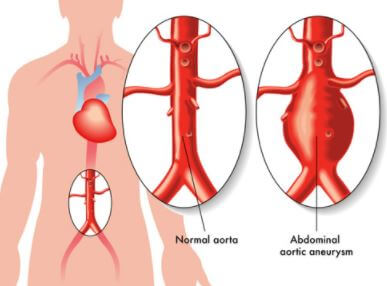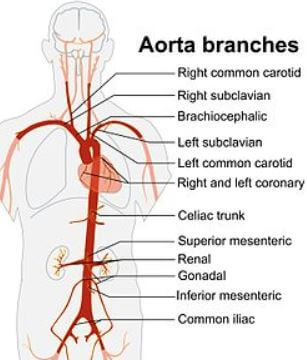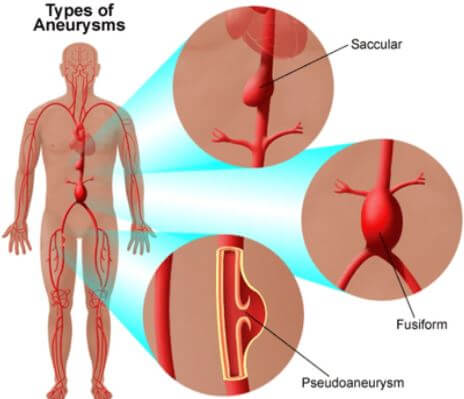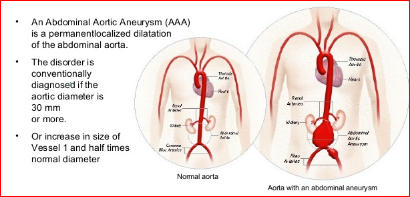Abdominal Aortic Aneurysm
What Is Abdominal Aortic Aneurysm?
An abdominal aortic aneurysm is a relatively common occurrence and can be a potentially life-threatening medical condition. Depending on the size of an aneurysm and the nature of its progression, the treatment may range from careful observation to an emergency surgical operation [1, 2, 3].

Aorta
The medical condition known as abdominal aortic aneurysm is an enlarged area in the lower portion of the blood vessel called the aorta [2]. The aorta is the largest among the arteries in the body. It is about 12 inches in length and just a little over an inch in its diameter.
There are several branches of this blood vessels that provide blood to body parts such as the heart, head, neck, ribs, and abdomen [4].

The walls of the aorta, like any other blood vessel, is composed of several layers. The intima is the innermost layer of the wall. It serves as the smooth surface where the blood flows freely.
The middle layer or media is composed of muscle and elastic fibers. It allows the aorta to contract and expand as a response to every heartbeat. The adventitia is the outer layer and it provides structure and support to the aorta [4].
Aneurysm
If the wall of a blood vessel weakens, it may cause an abnormally large bulge. This bulging can rupture and lead to an internal bleeding. An aneurysm may occur in any part of the body but the most common places where it may develop is the brain, aorta legs and spleen [5].
An abdominal aortic aneurysm is an aneurysm that develops in the abdominal branch of the aorta [1, 2, 3, 4]. Figure 1 shows an illustration of the development of an abdominal aortic aneurysm.

Figure 1- An abdominal aortic aneurysm
Types

Types of Aneurysm
An abdominal aortic aneurysm is classified on its size and the speed of its development or progression [6].
Small
An aneurysm is considered small if it is less than 6 centimeters in its diameter. They develop slowly and has a lower chance of rupturing [6].
Large
Any aneurysm that is more than 7 centimeters is its diameter is classified as a large aneurysm. They develop rapidly and are more prone to rupturing. This type of an aneurysm needs immediate management because of the risk of complications such as leaking of blood or internal bleeding [6].
Causes & Risk Factors
The exact cause of an abdominal aortic aneurysm is still unknown but there are certain risk factors which may increase the likelihood of an individual to develop an aneurysm [1, 6].
- Age is a risk factor and those who are over 65 years of age have the greatest risk.
- Hypertension or a high blood pressure becomes a risk factor because the pressure weakens the wall of the aorta.
- Smoking can cause damage to the walls of blood vessels and makes it more prone to bulging. Furthermore, cigarette smoking is also associated with increased blood pressure.
- Other possible risk factors include having a chronic obstructive pulmonary disease (COPD), coronary artery disease (CAD) or a previous repair for an aneurysm.
Signs and Symptoms
The development of an abdominal aortic aneurysm can be very slow and may take several years. An individual will not present any symptoms until the aneurysm has ruptured and caused internal bleeding.
If a rupture had taken place, the symptoms will appear rapidly and the patient should be taken to the hospital immediately. Some of the symptoms the patient may manifest include [1, 3, 6]:
- The pain felt in the abdomen or back. It may be described as sudden, persistent, severe, or constant. It may also be reported to spread in the buttocks, groin or legs.
- Dizziness
- Vomiting
- Nausea
- Passing out
- Elevated heart rate
- Shock

Diagnosis
Because of the lack of presenting signs and symptoms, an unruptured abdominal aortic aneurysm may be discovered or diagnosed while the patient is being examined for another condition. If an aneurysm is suspected, the physician may request additional tests such as an abdominal ultrasound, chest X-ray, and a CT scan or MRI of the abdomen [6].
Treatment & Management
The treatment and management of an abdominal aortic aneurysm would depend on the size and the location of the aneurysm. The physician would have to review the case of the patient to identify the best action to take [1, 2, 3, 6].
Unruptured aneurysm
Operating on a small unruptured aneurysm may not be preferred by the physician and they may just monitor its development in the meantime.
This is due to the low chance of the aneurysm to rupture and the risks associated with the surgical operation. The physician may also manage existing risk factors to further lower the risk of an aneurysm rupture. This may include the prescription of antihypertensive medications and smoking cessation [1, 2, 3, 6].
Ruptured aneurysm
A ruptured abdominal aortic aneurysm is considered an emergency and requires an immediate surgical repair by an experienced surgeon.
An open abdominal surgery or an endovascular surgical procedure may be performed on the patient. The open surgery would allow the surgeon to remove the damaged areas of the aorta but it has more risks and would require a longer recovery time for the patient.
In an endovascular surgery, the weakened walls of the aorta will be reinforced with the use of stents or grafts. The surgical procedure to be performed depends on the severity of the rupture and the ability of the patient to tolerate the procedure [1, 2, 3, 6].
Prevention
The occurrence of an abdominal aortic aneurysm may be prevented by following a healthier lifestyle. Keeping the blood pressure within the normal level and stopping smoking can help to lower the risk.
Those who are over 65 years of age with a history of cigarette smoking may be screened for an aneurysm by performing an abdominal ultrasound to the aorta. This procedure is painless and would only need to be performed once [6].
References
- Rahimi, S. A. (2016, December 19). Abdominal Aortic Aneurysm. Retrieved from Medscape: http://emedicine.medscape.com/
- Mayo Clinic Staff. (2016, MArch 23). Abdominal aortic aneurysm. Retrieved from Mayo Clinic: http://www.mayoclinic.org/diseases-conditions/abdominal-aortic-aneurysm/home/ovc-20197858
- Medline Plus. (2015, August 23). Abdominal aortic aneurysm. Retrieved from Medline Plus: https://medlineplus.gov/ency/article/000162.htm
- Hoffman, M. (2015, October 21). Picture of the Aorta. Retrieved from WebMD: http://www.webmd.com/heart/picture-of-the-aorta#3
- Macon, B. L., & Solan, M. (2015, December 11). Aneurysm. Retrieved from Healthline: http://www.healthline.com/health/aneurysm
- Macon, B. L., & Boskey, E. (2015, November 13). Abdominal Aortic Aneurysm. Retrieved from Healthline: http://www.healthline.com/health/abdominal-aortic-aneurysm#overview1
